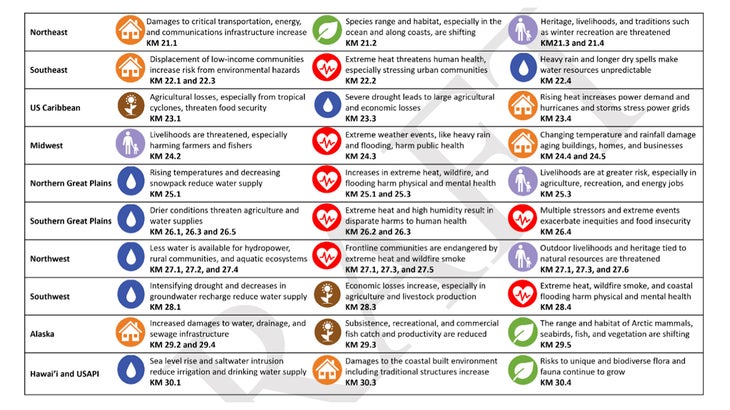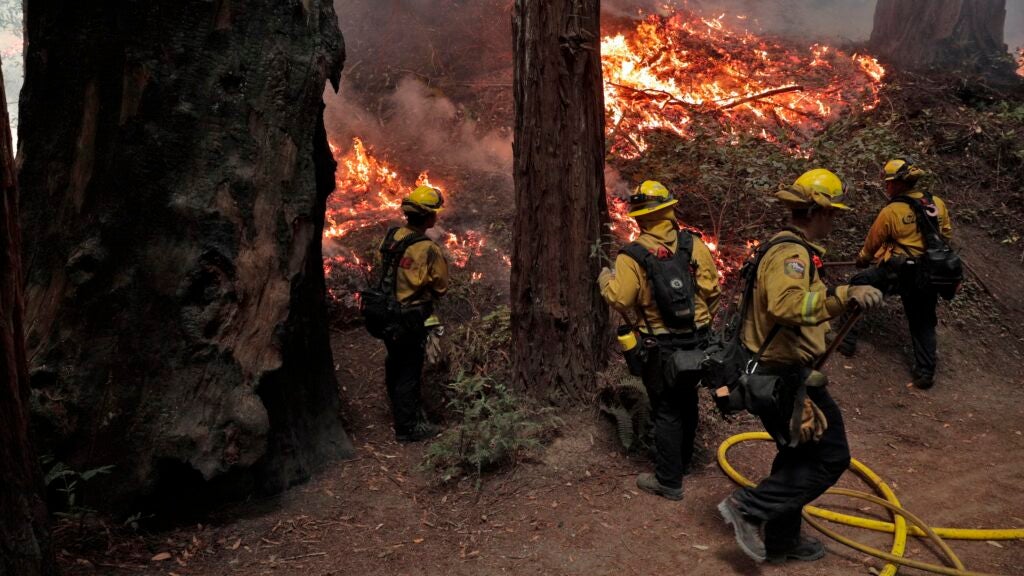No products in the cart.
Outdoor Adventure
How Bad Will Climate Change Get? Just Look at the U.S.
Last month, the United Nations issued a warning that the world is on track for at least 2.5 degrees Celsius of warming by the end of the century. Far more than the 1.5 degree increase targeted by the 2015 Paris Agreement. What will that look like? A draft of the National Climate Assessment, released last month, suggests we only have to look at the United States, right now, for at least some of the answer.
“Over the past 50 years, the U.S. has warmed 68 percent faster than the planet as a whole,” the assessment reads. While the world has already warmed about 1.1 degrees Celsius since pre-industrial times, the U.S. has warmed 1.4 degrees.
That means we’re experiencing some of the impacts of climate change sooner than other parts of the world might. And it’s going to get even hotter.
But average temperatures across an entire planet, or even just one country, paint a vague picture. What do they mean for you and me right now? “In the 1980s, the country experienced, on average, $1 billion-dollar (inflation-adjusted) event every four months,” says the assessment. “Now, there is one every three weeks on average.”
Those hundreds of billions are impacting our dollars and cents right now. “Worsening extreme weather events are causing direct economic losses through infrastructure damage, disruptions in critical services, and losses in property values,” it says. “The things Americans value most are at risk.”
National Climate Assessment Findings
The National Climate Assessment is an apolitical, Congressionally-mandated, interagency effort to summarize the past, current, and future impacts of climate change on the country. Published every four years, the report is legally mandated to employ the best possible science and is intended to inform the work of policy makers, emergency planners, financial risk managers, and other institutions. Here’s the fifth installment’s primary conclusions about how climate change is currently harming everyday Americans.
Extreme Weather Is More Harmful in an Interconnected World
The report finds that every region of the country is now impacted by “compound events,” in which one or more climate-related problem occurs at once. A good example is the record breaking heat that spread across the Pacific Northwest over 2020 and 2021. The heat coincided with drought, contributing to massive wildfires. Smoke from those wildfires exposed people to multiple health risks, while restricting outdoor activities (an important economic driver in the region) and worsening the summer 2021 Northwest heatwave, which killed 229 people. That heat also caused harmful algae blooms, reducing access to clean drinking water, and caused a mass die-off of shellfish and salmon. Altogether the heat cost the region at least $36 billion.
Climate Change Exacerbates Inequality
The effects of climate change are felt most by historically disenfranchised communities, who are least prepared to deal with them. “These frontline communities experience harmful climate impacts first and worst, yet are often the least responsible for the greenhouse gas emissions that cause climate change,” reads the report. “Climate change exacerbates existing risks to these communities from unmet infrastructure needs, low-quality housing, and other stressors creating cycles of worsening inequality.”

Everyone in the United States Is Feeling the Effects
While the risk an individual faces involves a myriad of factors, no area, community, or person is immune to the effects of climate change. The report breaks out these impacts by infrastructure, water supply, health and well-being, food security, livelihoods and heritage, and ecosystems, and assesses the risk by region.
Water Supplies Are Threatened
Both droughts and floods pose threats to the country’s water supply, in some areas combining to compound risks. “Urban and agricultural environments are especially vulnerable to runoff and flooding, which can damage crops and transport debris, fertilizers, chemicals, sewage, and other contaminants that contribute to the development of harmful algal blooms and contaminate drinking water supplies,” the report reads. “During 1981 to 2016, excessive rainfall led to a U.S. maize yield loss comparable to that from extreme drought.”
Then, between 1980 and 2021, heatwaves and droughts caused $291 billion (inflation adjusted) in damage. Coastal areas aren’t immune either. Sea level rise is causing saltwater to intrude into aquifers and wetlands. And, of course, decreasing snowpack reduces streamflow in the mountains, threatening downstream agriculture and municipal water supplies, while exacerbating wildfire severity.
Food Is Becoming Scarcer and More Expensive
Food is another area where multiple impacts cascade and hurt everything from crops and the workers who harvest them to supply chains that move food and supplies to and from consumers and producers.
The report calls out three main areas of concern:
- “Rising CO2 levels, increasing temperatures, and changes in precipitation reduce productivity, yield, and nutritional content of many crops. These changes can also introduce disease, disrupt pollination, and result in crop failure, outweighing potential benefits of longer growing seasons and increased CO2 fertilization.”
- “Heavy rain and storms damage crops and property and contaminate water supplies. Drought and wildfires reduce forage production and nutritional quality, diminish water supplies, and increase heat stress on livestock.”
- “Increasing water temperatures, invasive aquatic species, harmful algal blooms, and ocean acidification and deoxygenation put fisheries at risk. Fishery collapses can result in large economic losses, as well as loss of cultural identity and generational livelihoods.”
Americans’ Homes Are at Risk
Heavy rainfall, flooding, and wildfire are risking the physical safety of the places where we live. Less dramatically, older homes weren’t designed for the extreme temperatures caused by climate change, which is drastically increasing energy costs. And again, the associated problems compound.
“People who spend a high percentage of their income on energy costs—such as rural, low-income, and older fixed-income households, communities of color, and renters, are increasingly vulnerable to extreme heat events,” says the report. “For example, Black Americans are more likely than white Americans to live in older, energy-inefficient homes with structural issues, outdated appliances, and faulty energy systems. This disproportionate burden of energy insecurity is associated with higher incidence of poor health outcomes.”

Climate Change Is Already Forcing Americans to Relocate
One of the largest long-term concerns with climate change is that it may render many current high-density population areas uninhabitable. But the report finds that climate change is already displacing large populations of Americans within their own country.
Puerto Rico and the U.S. Virgin Islands were hit by numerous extreme events over the last two decades, driving migration of vulnerable communities to the mainland,” the report reads. “More severe wildfires in California, sea level rise in Florida, and more frequent flooding in Texas are expected to displace millions of people.”
When talking about infrastructure impacts, consider healthcare. It’s easy to see how more traffic traveling across an old bridge that’s increasingly battered by more extreme storms might cause a problem. It’s less obvious that those same climate change impacts are also stressing our healthcare infrastructure. Higher temperatures, exposure to storm or wastewater, and risks posed by events like storms is increasing demand for healthcare, the report finds. Climate change also increases the distribution and infectiousness of pathogens, wildfire smoke stresses the respiratory system, and exposure to pollen impacts reports of allergic reactions. These health concerns combined with food and water insecurity increase demand for already stressed healthcare resources, and impact the nation’s mental health.
Climate Change Is Threatening Indigenous Culture
“Indigenous communities, whose ways of life, cultures, intergenerational continuity, and spiritual health are tied to nature and the environment, are experiencing disproportionate health impacts of climate change,” the report reads. “Rising temperatures and increasingly extreme events are reducing biodiversity and shifting the ranges of culturally important species like Pacific salmon, wild rice, and moose, making it difficult for Indigenous peoples to fish, hunt, and gather traditional and subsistence resourcing within tribal jurisdictions. Heatwaves can prevent tribal members from participating in tribal ceremonies, while flooding, landslides, and wildfires increasingly disrupt or damage burial grounds and ceremonial sites.”
Economic Growth Is Slowing
The report finds that climate change is expected to reduce global economic output by about $23 trillion annually by 2050. The United States experiences half the annual global losses caused by extreme weather, a bill that costs us about $150 billion each year. Risks posed by climate change reduce the ability for governments to borrow money to fund infrastructure projects to prepare for climate change’s impacts. Household consumers are paying more for goods and services as a result of all the above.
Traditional Industries Are Disappearing
Climate change has already caused 14 major fishery collapses in Alaska. The report was written before news broke that Alaska’s king crab population has virtually vanished. Rapid shifts between wet and dry conditions, along with stress caused by increases in pests and pathogens is making it impossible to grow apples in the midwest, and wine grapes on the West Coast. Oil and gas jobs across the plains are disappearing. Recreation-dependent jobs like tourism in Hawaii or skiing in the Rockies are experiencing “significant economic loss.”
“Many beloved sports and outdoor activities are already being affected by climate change, with overall impacts projected to further hinder recreation, tourism, and the ability of communities to maintain a sense of place and heritage,” reads the report.
Climate Change Is Reducing Quality of Life
Many American households are already feeling the economic impacts of climate change,” reads the assessment. “Projected economic damages in a warmer world mean that household incomes will be slower to grow at the same time healthcare, food, insurance, building, and repair costs become more expensive. American’s quality of life is also threatened by climate change in ways that may be more difficult to quantify or predict, such as increased crime and domestic violence harm to mental health, reduced happiness, and fewer opportunities for outdoor recreation and play. These compounding stressors can increase segregation, reliance on social safety net programs, and income inequality.”
What Can We Do?
While many of these impacts are already occurring and are certain to get worse over coming decades no matter what we do, the assessment finds that cutting emissions in the near term remains the only way reduce harm for future generations.
Encouragingly, it also lays out some immediate benefits of cutting those emissions: “Accelerating the deployment of low-carbon technologies, promoting public transportation, providing subsidies to incentivize renewable energy and electric vehicle purchases, and improving building efficiency have significant near-term social and economic benefits,” the report states.
It also finds that, “reducing emissions of short-lived climate pollutants like methane improves air quality and saves lives while also reducing near-term warming.”
And “improvements in cropland management and practices like reduced tillage and diversification of crop rotations can increase soil carbon uptake and storage and enhance agricultural yields, strengthening the resilience and profitability of farms while also sequestering hundreds of millions of tons of CO2 each year.”
The list stops there. Less encouraging is the finding that accompanied the UN’s prediction that at least 2.5 degrees Celsius of warming by 2100 is already certain. Despite commitments to the contrary and the certain conclusion that our only hope is to drastically cut, if not entirely eliminate, the production of global warming gases, the global economy is currently on track for a 10.6 increase from 2010 levels in annual emissions by 2030.
Source link

